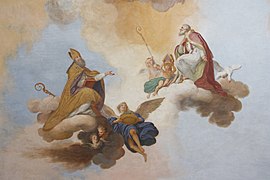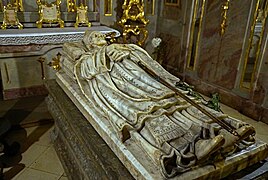Ulrich of Augsburg
Saint Ulrich of Augsburg | |
|---|---|
weavers; San Dorligo della Valle |
Ulrich of Augsburg (890 – 4 July 973), sometimes spelled Uodalric or Odalrici, was Prince-Bishop of Augsburg in the Holy Roman Empire. He was the first saint to be canonized not by a local authority but by the pope.[3]
Life
Early years
Much of the information concerning Ulrich is derived from the Life of St Ulrich written by Gerhard of Augsburg sometime between 982 and 993. Ulrich was born in 890 at
As was customary, his parents presented him as an
Bishop of Augsburg

Through the influence of his maternal uncle,
During the struggle between Otto I and his son Liudolf, Duke of Swabia, Ulrich remained loyal to Otto,[8] holding for him the castle of Schwabmünchen, which was within the territorial jurisdiction of the Bishop of Augsburg.[5] When in the summer of 954 father and son were ready to attack each other at Illertissen in Swabia, at the last moment Ulrich and Bishop Hartbert of Chur were able to mediate between Otto and Liudolf. Ulrich succeeded in persuading Liudolf and Conrad, Duke of Lorraine, Otto's son-in-law, to ask the king's pardon on 17 December 954.
Against the Magyars
Soon after, the Magyars entered Germany, plundering and burning as they went, and in 955 advanced as far as Augsburg, which they besieged. It was due to Ulrich's ability and courage that Augsburg was able to hold out against the besiegers until the Emperor Otto arrived. According to his biographer Gerhard, Bishop Ulrich took the lead in the defense of the city. On the first day of the attack, Bishop Ulrich rode out to encourage the towns' soldiers in their defense of the city's gate. While the battle raged, the bishop, dressed in his ecclesiastical robes, inspired his men, with the 23rd Psalm ("Yea, though I walk through the valley of the shadow of death"). While this defense was going on, the King was raising an army to march south.[9] The fiercest fighting probably took place on 8 August at the eastern gate, which the Hungarians tried to storm in large numbers. The Bishop's men defended the gate bravely and killed the leader of the attack, forcing the Hungarians to withdraw. That evening Ulrich returned to the city to direct throughout the night the repair and strengthening of its walls.[5] The next day the Hungarians launched a wider general attack. During the battle, Berchtold of Risinesburg arrived, which heralded the approach of the German army. At the end of the day, the siege was suspended.[10] Ulrich's ability to hold out during the siege bought precious time for the emperor.[6]

Ulrich subsequently contributed much to the decisive victory at the Battle of Lechfeld (10 August 955), where the invaders were finally defeated.[7] However, Ulrich Schmid maintains that "The later assertion that Ulrich himself took part in the battle is incorrect."[4]
His character

Ulrich demanded a high moral standard of himself and others. A hundred years after his death, a letter apparently written by him, which opposed
Later life
Ulrich took part in the Diet held on 20 September 972, when he defended himself against the charge of nepotism in regard to his nephew Adalbero, whom he had appointed his coadjutor on account of his own illness and desire to retire to a Benedictine abbey.[12] Ulrich did, in fact, resign as prince-bishop and retired to Ottobeuren Abbey, where he became abbot.
As morning dawned on 4 July 973, Ulrich had ashes strewn on the ground in the shape of a cross; the cross sprinkled with
The maniple of Ulrich was woven in red and white silk using tablet weaving and Ulrich's relic was later analyzed by Peter Collingwood in his The Techniques of Tablet Weaving; Collingwood regarded it as a 'masterpiece'.[14]
Veneration

When Ulrich was too old and weak to say Mass, angels are said to have come to him to assist him. Places that were named after him are said to be host to healing abilities. Attesting to his early cultus, there is a very beautiful miniature from the tenth century in a manuscript now in the library of Einsiedeln.[15] Other miniatures are at the Royal Library of Munich, in manuscripts dating from the year 1454.[16]
Many
Patronage
Along with Afra and Simpert, Ulrich is a patron saint of Augsburg. Legend held that pregnant women who drank from his chalice had easy deliveries, and thus developed his patronage of pregnant women and easy births. The touch of his pastoral cross was used to heal people bitten by rabid dogs.[17]
The veneration of Ulrich was carried to the Western Hemisphere by the German Catholic peasant pioneers whom Francis Xavier Pierz persuade to settle in central Minnesota following the Treaty of Traverse des Sioux in 1851. Along with Magnus of Füssen, Ulrich's intercession was credited with the defeat of the 1856-1857 Rocky Mountain locust plague, and both saints continued afterwards to be venerated in and around Stearns County, Minnesota, with pilgrimages and religious processions. (See also Assumption Chapel).[20]
Gallery
-
Saint Ulrich in Heaven, Parish church of Urtijëi
-
The glorification of Saint Ulrich and Saint Martin
-
Saint Ulrich from Augsburg in the battle, Parish church of Urtijëi
-
Tomb of Saint Ulrich
-
Saints Ulrich of Augsburg, Saint Afra and Simpert
-
Miracle of Saint Ulrich by Szymon Czechowicz
-
Saint Ulrich and Saint Wolfgang, 1510
-
The Battle of Lechfeld, ceiling fresco by Balthasar Riepp, 1744, in the Seeg parish church
References
- ^ ISBN 9780814623770.
- ^ Stracke, Richard (20 October 2015). "Ulrich of Augsburg". Christian Iconography.
- S2CID 159681002.
- ^ a b c d Schmid, Ulrich. "St. Ulrich." The Catholic Encyclopedia. Vol. 15. New York: Robert Appleton Company, 1912. 25 January 2014.
- ^ a b c Abels, Richard. "The "Church" and the Lay Aristocracy, ca. 950: The Case of Saint Ulrich of Augsburg". USNA.
- ^ ISBN 9789004111202
- ^ a b Lins, Joseph. "Augsburg." The Catholic Encyclopedia. Vol. 2. New York: Robert Appleton Company, 1907. 25 Jan. 2014
- ^ Hehl, Ernst-Dieter. "Ulrich of Augsburg." Religion Past and Present. Brill Online, 2015. Reference. 26 March 2015
- ^ Delbrück 1982, p. 115.
- ^ Delbrück 1982, p. 678.
- ^ cf. "Analecta Boll.", XXVII, 1908, 474
- ^ "Saint Ulrich | German bishop". Encyclopedia Britannica. Retrieved 30 June 2021.
- ^ Schmid, U. (1912). St. Ulrich. In The Catholic Encyclopedia. New York: Robert Appleton Company. Retrieved 30 June 2021 from New Advent: http://www.newadvent.org/cathen/15123a.htm
- ISBN 9780823052554.
- ^ no. 261, fol. 140
- ^ Cgm., 94, fo. 26v, and Cgm., no. 751
- ^ a b "St. Ulrich of Augsburg", Catholic News Agency
- ^ William Smith, Samuel Cheetham, A Dictionary of Christian Antiquities (Murray, 1875), 283.
- ^ Alexander III
- S2CID 159890053.
![]() This article incorporates text from a publication now in the public domain: Herbermann, Charles, ed. (1913). "St. Ulrich". Catholic Encyclopedia. New York: Robert Appleton Company.
This article incorporates text from a publication now in the public domain: Herbermann, Charles, ed. (1913). "St. Ulrich". Catholic Encyclopedia. New York: Robert Appleton Company.
Sources
- Delbrück, Hans (1982). History of the Art of War. Vol. Three: Medieval Warfare. Lincoln and London: University of Nebraska Press. ISBN 0-8032-6585-9.
- Gerhard of Augsburg wrote about St. Ulrich's life, the Vita Sancti Uodalrici and several books about his miracles have been written as well.
- Opera Omnia by Migne Patrologia Latina with analytical indexes








